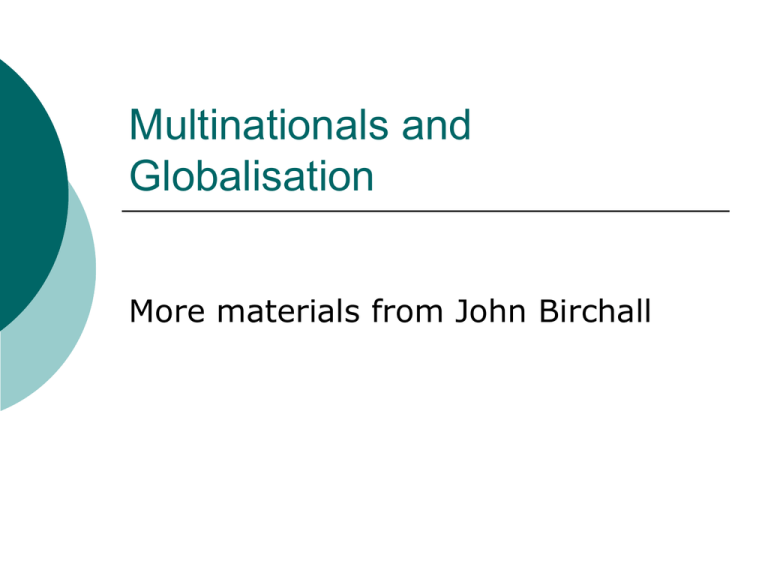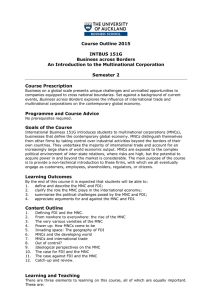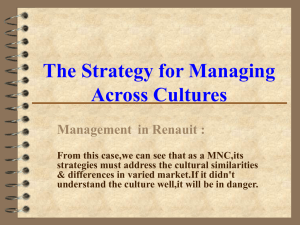Multinationals and Globalisation
advertisement

Multinationals and Globalisation More materials from John Birchall Globalisation: Setting the Scene Current issues in the global economy Defining globalisation global economic interdependence implications for business What is driving globalisation? market drivers cost drivers government drivers competitive drivers The drivers of globalisation Market drivers Cost drivers Per capita income converging among industrialised nations Continuing push for economies of scale Convergence of lifestyles and tastes Organisations beginning to behave as global customers Increasing travel creating global consumers Growth of global and regional channels Establishment of world brands Accelerating technological innovation Advances in transportation Emergence of newly industrialised countries with productive capability and low labour costs. Increasing cost of product development relative to market life Push to develop global advertising Government drivers Competitive drivers Reduction of tariff barriers Continuing increases in the level of world trade Reduction of non-tariff barriers Increased ownership of corporations by foreign acquirors Creation of blocs Decline in role of governments as producers and customers Rise of new competitors intent upon becoming global competitors Privatisation in previously state-dominated economies Growth of global networks making countries interdependent in particular industries Shift to open market economies from closed communist systems in eastern Europe Increasing participation of China and India in the global economy More companies becoming globally centred rather than nationally centred Increased formation of global strategic alliances Other drivers Globalisation of financial markets Revolution in information and communication Improvements in business travel Comparison of the 10 largest multinational corporations (by gross revenue) and selected countries (by GDP): 2002 MNC rank 1 2 3 4 5 6 7 8 9 10 Country or Company USA Wal-Mart Stores Indonesia Denmark Exxon Mobil General Motors BP Greece China: Hong Kong Ford Motor Finland Ireland Enron DaimlerChrysler Royal Dutch/Shell Group Thailand Iran General Electric Argentina Toyota Motor Malaysia Chile Luxembourg Kenya Albania GDP ($bn) or gross revenue ($bn) 10,869.1 219.8 212.9 205.1 191.6 177.3 174.2 165.2 165.1 162.4 158.2 150.2 138.7 136.9 135.2 132.4 127.8 125.9 121.8 120.8 102.7 65.9 23.8 12.9 5.3 FDI inflows ($ millions) 1,600,000 1,400,000 World 1,200,000 FDI inflows ($ millions) . Developed countries Developing countries 1,000,000 800,000 600,000 400,000 200,000 0 1970 1975 1980 1985 1990 1995 2000 FDI inflows FDI as % of gross fixed capital formation 30.0 25.0 Developed countries 20.0 15.0 Developing countries 10.0 5.0 0.0 1985 1990 1995 2000 Multinational Corporations Diversity among MNCs size the nature of the business overseas business relative to total business production locations ownership patterns organisational structure Why do Businesses go Multinational? Categories of multinational organisation horizontally integrated vertically integrated conglomerate Advantages to firms reductions in costs international differences in factor prices international differences in factor productivity low-cost access to local markets spreading overheads Why do Businesses go Multinational? Advantages to firms (cont.) government support in host countries increased demand spreading risks can exploit advantages over local firms lower taxes subsidies provision of infrastructure ownership of superior technology entrepreneurial and managerial skills R&D capacity access to local technology Why do Businesses go Multinational? The product life cycle and the MNC the launch phase the growth phase maturity late maturity and decline Problems facing multinationals language barriers selling and marketing relations with host governments relationships between subsidiaries MNC Investment and the Host State Advantages of MNC investment employment balance of payments technology transfer tax revenues Disadvantages uncertainty power and control by the MNC over the host transfer pricing the environment MNCs and Developing Countries The scale of MNC investment in developing countries Advantages to host country the saving gap the importance of development finance the contribution of saving to growth the foreign exchange gap public finance gap skills and technology gaps MNCs and Developing Countries Disadvantages to host country MNCs may drive local firms out of business limited demand for local components repatriation of profits transfer pricing and effects on tax revenues competition between developing countries to attract MNCs distorting the whole pattern of development increasing gap between rich and poor What can developing countries do? Accept a period of considerable economic control being in external hands Aim to negotiate best tax, royalty deals Insist on training, environmental awareness and social concern being part of MNC responsibility Spend receipts on sustainable development Link aid, inward investment and domestic enterprise, so adding value and keeping a high proportion of this within the country. GDP and GDP Growth - Zimbabwe











